More than two and half thousand years ago(624 BC), in a land nestled in the foothills of the mighty Himalayas, Lumbini(now in present-day Nepal)- a land endemic with war, suffering, poverty, and ignorance a prince was born. The king was overjoyed and vowed never to let the prince see any pain. Prince Siddharta is destined to be a powerful warrior king, so the king thought. Young Siddharta Gautam lived a life of opulence. Full of all the riches and comforts a royal household can bestow, Siddharta remained insulated from pain and suffering. Until one day, when he went out. He encountered a sick man, then a decrepit old man and then a dead person. His image of life as he knew it – full of comforts, riches, opulence, and power, lay shattered. He saw pain, suffering, and impermanence. He felt the fear of dying, of losing his loved ones and all the comforts of a royal life. He buried himself in thought. On his next outing, he saw an ascetic meditating. He realized then, that the answer to his troubles lay inside him and he must find answers to those vexing questions. Most pressing question being, how to escape the cycle of birth, rebirth, and death-“Samsara”.
In pursuit of answers, he left his royal life and ventured into the unknown. For six years he persevered. In his journey, he met many teachers. They all showed him the potential of mind but the answers were still elusive. At Bodh Gaya (a city in present-day Bihar in India), under the sacred fig tree (Ficus religiosa), he pushed his body to the limit, fasting continuously- lost in thought, determined to find the truth. His body shriveled, muscles lost, eyes sunk, bones jutted out like branches of a withering tree. But it did not help, he did not get his answers. While in repose, he was continuously distracted by the “Mara”, the lord of desire. “Mara” was afraid that Siddharta would ruin his kingdom of desire. Frustrated, “Mara” sent three of his daughters to seduce Siddharta. Siddharta held himself, resisting all temptation while Mara demanded Siddharta to produce a witness of his “awakening”. Siddharta reached down and touched the earth. With a shudder, the earth bore testimony and “Maara’s” demons vanished. He continued his meditation through the night. He envisioned all his previous lives. He envisioned the working of the universe. At the crack of dawn, he feels himself and world around him at peace. He experiences unparalleled joy. He feels “awakened”.
He becomes the Buddha–The Awakened One. His reverence for the earth is seen in one of his postures, left hand nestled in his lap and right resting on his knee, fingertips touching the ground. From there on, Buddha(Siddhartha post his enlightenment) becomes a teacher and wanders across north India for over 45 years. While leaving his body at the age of eighty, he advises his followers to “Be your own light”, to question and discover for themselves. His followers continued to grow and Buddhism spread across continents – across the Indian subcontinent, southeast Asia, China, Japan, Korea and even Europe.
Art of the earth: Tsha tshas
Buddha’s teachings flourish in the sacred arts his followers evolved over centuries. Buddhist art is practiced in various forms –paintings, sculpture, architecture, and textiles. Various art forms continue to convey religious narratives and continually give messages from an evolved set of spiritual beings.
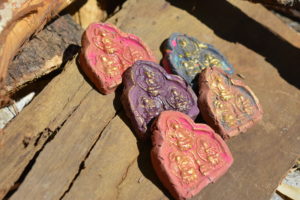
One such art form is Tsha Tsha– clay art. Typically, these are stamped clay images. Widely believed to carry spiritual powers, the Tsha Tshas are widely used across the mountainous northern regions comprising Nepal, Bhutan, Tibet and Sikkim(India). The purpose of Tsha Tshas is to ward off evil and bring good tidings. Passing a river, on top of a mountain, by the temple – Tshas tshas can be found at all sacred spaces. It is a prayer, an art, a belief all combined in one. It is art for everyone. It is a prayer for everyone. Much like the prayer wheels that turn endlessly, the colorful prayer flags that flutter in all seasons and spread the power of prayers far and wide, so do the “tsha tshas”. Made of clay, they possess beneficial healing energies.
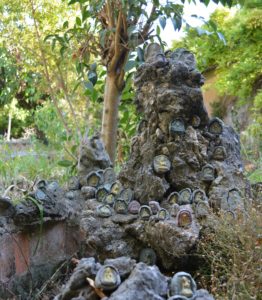
Like most of the Buddhist art, Clay tshas tshas carry iconography turning art into a religious teaching tool. Clay Tsha tshas primarily come in three forms: Figurative(single or multiple), text plaque and stupa shapes. They depict the bedrock of spiritual belief: a life of Buddha in different phases, his struggle to attain enlightenment, Nirvana, penance, struggles with Mara, teachings of the Buddha and so on.
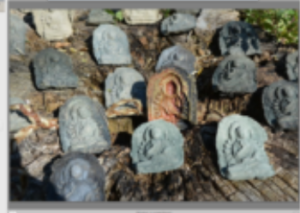
Tshas are a part of popular culture. Auspicious occasions like marriages, religious initiations, a start of a new vocation are times to offer these prayers in clay. Mothers often enclose them in a leather case or gauze and gift it to their children as a prayer which stays with them to ward off evil energies and Stupa shapes bring good luck.
“When the wind blows, the energies and prayers condensed in the Tsatsa are scattered in the space…” says Nyima Dolma Sundari, an Acharya adept at making Tsha Tshas.
Making the tsha tshas itself is a meditative process. The art is passed on from master to disciple.
“Making Tsa-Tsas pacifies obstacles, bad conditions, accidents, and sudden diseases like heart attacks and paralysis. By making Tsa-Tsas you pacify enemies, interferers, and harms. You accumulate all merit, purify all obscurations and achieve the resultant three kayas in a future life”.– ‘Lama Zopa Rinpoche’.
With the spread of Buddhism, experiments are being made with the material used for tsha tshas with the primary objective to make them more durable. An alternative material being used for making Tsha tsha are plaster, hydro stone, and even architectural-grade gypsum. From traditional amulets and tablets, artists like Nyima Dolma Sundari are innovating. Painted, made of wood, given a form of books and boxes, crafted on hand prayer wheels are some ways in which tsha tsha art is reaching out to more and more people across the globe. The spread of Buddhism to Europe has seen tsha tsha studios coming up and stirring interest in people to know more about them.
In a word of his Holiness The Dalai Lama – “If you bring more happiness to others, a benefit to others – you get benefitted with more inner strength, more confidence, and fulfillment of the purpose of life. Then, you feel happy”. Tsha tshas carry the tradition of carrying this message of universal peace.
Submitted by: Faiz Ahmad; faiz458@hotmail.com
Photo Credits: Nyima Dolma Sundari

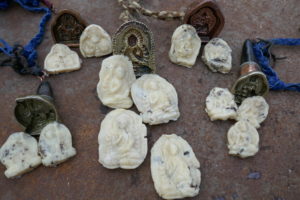
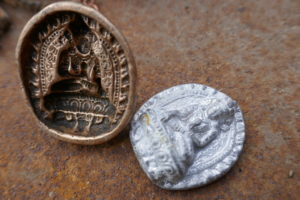

One Response
[* Shield plugin marked this comment as “0”. Reason: Human SPAM filter found “wonderful article” in “comment_content” *]
Thank you very much himalayan art for your article about this incredible and unknown sacred buddhist of tsha-tsha! I appreciated a lot your curiosity, understanding and involvement to translate our interviews into this wonderful article. Excellent contact and work, thank you very much, Regards Nyima